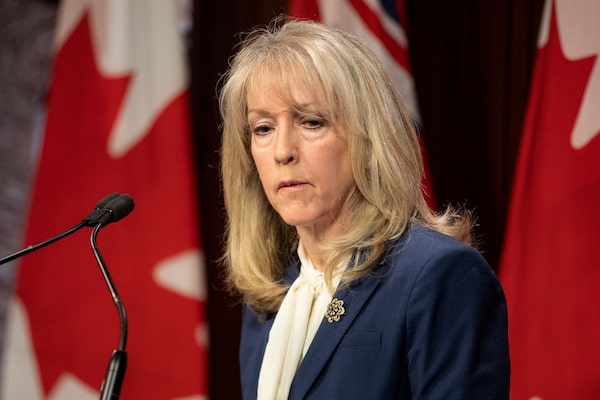
Ontario Long-Term Care Minister Merrilee Fullerton speaks at Queen's Park, in Toronto, on May 3, 2021.Chris Young/The Canadian Press
The 322-page final report of Ontario’s Long-Term Care Commission was released at 7:18 p.m. on Friday night – the political equivalent of taking a shovel, digging a deep hole and burying it.
Then, on Monday morning, the province delivered another slap in the face to Ontario’s elders when Long-Term Care Minister Merrilee Fullerton offered up a mealy-mouthed response to the report, featuring such gems as “fixing the problem will take many solutions.”
There is nothing surprising or new in the report, though that’s not a knock on the commissioners. It’s hard to come up with anything groundbreaking when more than 150 reports have been written since the advent of medicare about how to fix the hellishly inadequate long-term care system.
There was nothing unexpected in the government’s response, either. Blaming previous governments for all failings and making vague commitments to do something, sometime – that’s all standard political fare.
But at some point, politicians have to stop commissioning reports that they intend to send directly to the dumpster and start implementing the long-overdue and eminently sensible recommendations therein.
The latest report – which the authors didn’t even bother gracing with a catchy title such as “Now Is The Time” – features 85 recommendations. They are centred around three points: care homes are hard-pressed to offer decent care because they are chronically understaffed; the infrastructure is horribly outdated and inadequate; and inspection and regulation of homes is a joke.
On the first issue, the report calls for urgently needed legislated standards to guarantee residents receive four hours of daily hands-on care (up from the current 2.75 hours). The mix of staff matters too: it should be 20 per cent registered nurses, 25 per cent registered practical nurses and 55 per cent personal support workers. More nurse-practitioners are needed for oversight, and medical directors need to be geriatric specialists.
On the second issue, not only are more beds needed, they should be home-like: no more four-bed ward rooms and bathrooms shared by up to eight people. Ownership matters too, but it’s not as simple as eliminating for-profit operators. The most intriguing recommendation is to separate the ownership and construction of LTC homes from their operation – in other words, not allowing real-estate companies to be care providers.
The commission also calls for a “co-ordinated and comprehensive long-term care inspection regime,” including regular and unannounced inspections, plus transparency and follow-up on findings.
One of the most useful aspects of this type of quasi-judicial exercise is providing a clear, factual chronology of government action (and inaction) – something that is hard to grasp in real-time. It is hard for readers to consume the dry recitation of events and not be sickened by the failure of government officials to take the clear threat to long-term care homes seriously. “It was not always clear who was in charge” – these words, from the review of Canada’s handling of the SARS crisis, echo to this day.
The commission notes that the bulk of long-term care residents who died in the first wave of the pandemic did so or were infected between March 22 and April 22, 2020. Most (but not all) were preventable, but sitting on one’s hands was the modus operandi in that period.
Given the deadly bungling during that stretch of time, why did Dr. David Williams, the province’s Chief Medical Officer of Health, still have a job afterward? The death count was even higher in the second wave than the first; clearly nothing was learned. So why is Dr. Williams still “in charge” now?
The many, many reports such as this one almost all suffer from the same fundamental flaw: a lack of details about how to implement recommendations. What is the point of saying, as this latest report does, that 55,000 more long-term care beds will be needed by 2023 without providing a full costing and timetable? When there is no concrete goal and budget, it’s easy for government to weasel its way out of acting and, as Ms. Fullerton did Monday, utter vague platitudes such as “we are fixing a broken system.” Yes, the province had announced $9.6-billion in new spending on LTC, but most of it is supposed to happen after the next election – so really, that’s no commitment at all.
Simply saying that government should provide a progress report on implementation one and three years later – as the commissioners have done – is to let officials off the hook.
Prior to COVID-19, there was no plan to improve the lives of elders in care. Thousands of deaths later, there is still no actionable plan.
“Delay is deadly,” the commissioners wrote. Indeed it is. And as long as we keep burying reports under delays and a lack of will, we will keep burying elders who have been cruelly neglected.
Keep your Opinions sharp and informed. Get the Opinion newsletter. Sign up today.
 André Picard
André Picard